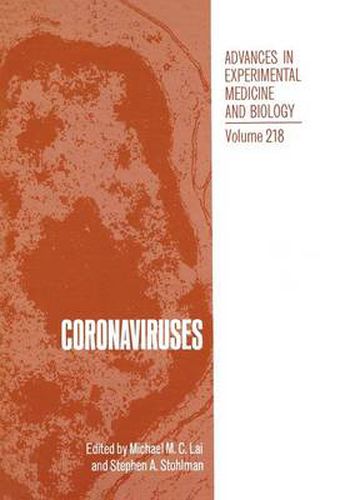Readings Newsletter
Become a Readings Member to make your shopping experience even easier.
Sign in or sign up for free!
You’re not far away from qualifying for FREE standard shipping within Australia
You’ve qualified for FREE standard shipping within Australia
The cart is loading…






This title is printed to order. This book may have been self-published. If so, we cannot guarantee the quality of the content. In the main most books will have gone through the editing process however some may not. We therefore suggest that you be aware of this before ordering this book. If in doubt check either the author or publisher’s details as we are unable to accept any returns unless they are faulty. Please contact us if you have any questions.
Coronaviruses have emerged during the past ten years from being a group of viruses causing a variety of minor veterinary and human diseases to a major virus group of both clinical significance and molecular biological interest. Against this background, two international coronavirus symposia were held in 1980 and 1983. In recent years, the pace of coronavirus research has been quickened even more by infusion of recombinant DNA technology and establishment of various animal model systems to study the pathogenesis and immunology of coronavirus infections. We therefore organized the Third International Coronavirus Symposium held at Asilomar, California in September 1986, which was attended by more than 120 participants representing a cross section of both academia and industry. This symposium provided an exciting and stimulating forum for assessing the progress made since the last triennial symposium in Netherlands and to suggest the directions for future efforts. This volume collects the scientific papers presented in this symposium. Three loosely defined areas, Molecular biology, Virus-Cell Interaction and Viral Pathogenesis, are separated. These papers very nicely summarize the current status of coronavirus research. They contain a large amount of sequence data, including the complete sequence of a 27 Kb coronavirus genome, a novel mechanism of mRNA synthesis that is unique to coronviruses, and many exciting aspects of coronavirus pathogenesis and immunology. Reflecting the growing interest in the preparation of vaccines, several papers also address the issues related to coronavirus vaccines, which is an area new to this symposium. Dr.
$9.00 standard shipping within Australia
FREE standard shipping within Australia for orders over $100.00
Express & International shipping calculated at checkout
This title is printed to order. This book may have been self-published. If so, we cannot guarantee the quality of the content. In the main most books will have gone through the editing process however some may not. We therefore suggest that you be aware of this before ordering this book. If in doubt check either the author or publisher’s details as we are unable to accept any returns unless they are faulty. Please contact us if you have any questions.
Coronaviruses have emerged during the past ten years from being a group of viruses causing a variety of minor veterinary and human diseases to a major virus group of both clinical significance and molecular biological interest. Against this background, two international coronavirus symposia were held in 1980 and 1983. In recent years, the pace of coronavirus research has been quickened even more by infusion of recombinant DNA technology and establishment of various animal model systems to study the pathogenesis and immunology of coronavirus infections. We therefore organized the Third International Coronavirus Symposium held at Asilomar, California in September 1986, which was attended by more than 120 participants representing a cross section of both academia and industry. This symposium provided an exciting and stimulating forum for assessing the progress made since the last triennial symposium in Netherlands and to suggest the directions for future efforts. This volume collects the scientific papers presented in this symposium. Three loosely defined areas, Molecular biology, Virus-Cell Interaction and Viral Pathogenesis, are separated. These papers very nicely summarize the current status of coronavirus research. They contain a large amount of sequence data, including the complete sequence of a 27 Kb coronavirus genome, a novel mechanism of mRNA synthesis that is unique to coronviruses, and many exciting aspects of coronavirus pathogenesis and immunology. Reflecting the growing interest in the preparation of vaccines, several papers also address the issues related to coronavirus vaccines, which is an area new to this symposium. Dr.